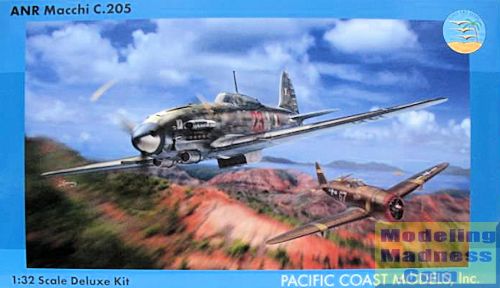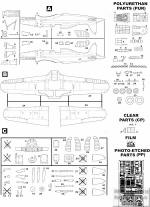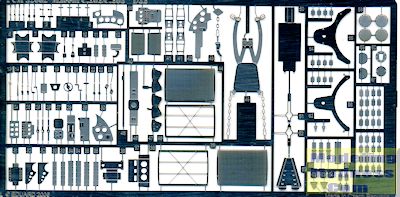
Pacific Coast Models 1/32 Macchi C.205 'Veltro'
| KIT #: | 32-003 |
| PRICE: | $60.00 when new in 2006 |
| DECALS: | Seven options |
| REVIEWER: | Scott Van Aken |
| NOTES: |
Short run with resin and photo etch parts |

| HISTORY |
The Macchi C.205 (also known as MC.205, "MC" standing for "Macchi Castoldi") Veltro (Italian: Greyhound) was an Italian World War II fighter aircraft built by the Aeronautica Macchi. Along with the Reggiane Re.2005 and Fiat G.55, the Macchi C.205 was one of the three "Serie 5" Italian fighters built around the powerful Daimler-Benz DB 605 engine. The C.205 was a development of the earlier C.202 Folgore. With a top speed of some 400 mph and equipped with a pair of 20 mm cannon as well as 12.7 mm Breda machine guns, the Macchi C.205 Veltro was highly respected by Allied and Luftwaffe pilots alike. Regarded as the best Italian aircraft of World War II, in action it proved to be extremely effective, destroying a large number of Allied bombers and capable of successfully clashing on equal terms with such renowned fighters as the North American P-51D Mustang, a capability which encouraged the Luftwaffe to use a number of these aircraft to equip one Gruppe.
However, while the C.205 was able to match the best Allied opponents in speed and maneuverability, it was introduced late in the conflict. Moreover, due to the poor Italian industrial capability of the time, only a small production run was delivered before the end of the war. Like the Spitfire, the Veltro was tricky (in its construction) and thus slow to build. Italy's highest scoring ace, Adriano Visconti, achieved 11 of his 26 credited victories in the few weeks he was able to fly the Veltro, with the top scoring 205 Sergente Maggiore pilota Luigi Gorrini shooting down 14 enemy aircraft plus six damaged with the C.205.
| THE KIT |
 This
kit was PCM's third full kit and released in 2006. Like its predecessors, it was
basically a product of the Czech Republic with the kit molded by MPM, the photo
etch by Eduard and I assume the resin was also done there. The decals were
designed by Sky decals and printed by Cartograf. Their kits still follow this
same basic formula, though I believe that all kits after this had the injected
plastic done by Sword.
This
kit was PCM's third full kit and released in 2006. Like its predecessors, it was
basically a product of the Czech Republic with the kit molded by MPM, the photo
etch by Eduard and I assume the resin was also done there. The decals were
designed by Sky decals and printed by Cartograf. Their kits still follow this
same basic formula, though I believe that all kits after this had the injected
plastic done by Sword.
This kit is pretty much the same as the C.202 kit that preceded it, differing only in the cowling bits that are the major difference between the DB.601 powered C.202 and DB.605 powered C.205. The 202 kit was lambasted rather badly for poor fit in terms of both the plastic and the resin parts, and airframe parts that were basically for the C.205. Well, since this is a C.205, we can eliminate that last complaint.
 Despite
being a relatively 'simple' single engine prop aircraft, there are a zillion
parts, most of them photo etch. Pretty much anything smaller than the inner gear
door is done in photo-etch so if you are not comfortable with this material, you
may want to skip this kit as it is used pretty much everywhere with the cockpit
being chock full of the stuff. There is an acetate sheet with instruments on it
to put behind the p.e. instrument panels.
Despite
being a relatively 'simple' single engine prop aircraft, there are a zillion
parts, most of them photo etch. Pretty much anything smaller than the inner gear
door is done in photo-etch so if you are not comfortable with this material, you
may want to skip this kit as it is used pretty much everywhere with the cockpit
being chock full of the stuff. There is an acetate sheet with instruments on it
to put behind the p.e. instrument panels.
Same goes for the resin bits. These are used for any areas that have a lot of detail. Even some of the plastic bits have resin replacements. Resin is used for things like wheels, the lower cowling, oil coolers, exhaust, cannon barrels, radiator housing, cockpit floor and sidewalls, tail gear and the list goes on.
You will have to do a bit of surgery as the tail cone needs to be cut off and replaced with the one designed for the C.205. You'll also not be pleased that the exhaust has to be installed before the fuselage halves are cemented together, but if you have nimble fingers you might be able to glue them in place at the very end before gluing on the lower engine cowling.
 While the
ailerons are molded into the wings, the rudder and elevators are not. However,
they appear to be molded only for the neutral position as these bits have flat
mating surfaces. The only real option I saw was for one of two different radio
masts. Even the cockpit canopy, though separate, does not seem to have any
molded on hinges, so you'll need to butt glue it if you wish to pose it open.
The instructions show it closed.
While the
ailerons are molded into the wings, the rudder and elevators are not. However,
they appear to be molded only for the neutral position as these bits have flat
mating surfaces. The only real option I saw was for one of two different radio
masts. Even the cockpit canopy, though separate, does not seem to have any
molded on hinges, so you'll need to butt glue it if you wish to pose it open.
The instructions show it closed.
The instructions are very nicely done. They are in book form and have large drawings. Color information is generic, though most of us realize that when they say 'interior green', it means that lighter shade used by Italy. The markings options are quite nice. There are seven options. Three of them are from before the armistice, one is German and the other three are from the ANR. Two of the ANR options are in RLM 74/75/76, though no upper surface painting guide is provided. The others are all in a tan with the green 'smoke rings' over the upper surfaces. The decal sheet is very nicely done by Cartograf. In the painting and markings booklet, Italian color information is provided.
| CONCLUSIONS |
| REFERENCES |
http://en.wikipedia.org/wiki/Macchi_C.205
December 2014 Thanks to me for picking up the preview kit. If you would like your product reviewed fairly and fairly quickly, please contact the editor or see other details in the
Note to
Contributors.